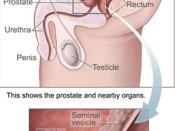Prostate Cancer
Abstract
This report incorporates the most authoritative and most current scientific information on the treatment of prostate cancer (PC). It covers three basic and essential categories of information on PC: 1) an introduction and review of PC, anatomy of the urethra, incidence of prostate cancer, and risk factors, 2) detection and treatment methods which are currently employed by diagnosticians, 3) the benefit of early PC detection, and quality of life outcomes in men treated for PC.
Prostate Cancer
The prostrate surrounds the urethra between the base of the bladder and the muscular sheet that makes up the floor of the pelvic cavity. The prostate is nestled at the bottom of this cavity, surrounded by blood vessels, nerves, and connective tissue. All male animals have some type of a prostate gland; it is fundamental to our evolution
The primary function of the prostate is to produce semen. Semen consists of proteins and other chemicals that nourish the sperm and are critical to male fertility.
The portion of the semen made in the prostrate helps preserve and transport the sperm that are formed in the testicles and stored in the adjacent epididymis. Without the prostate, reproduction through sexual intercourse would be impossible.
At the time of orgasm, when ejaculation occurs, the sperm are expelled through two long muscular tubes called the vas deferens, commonly called the vas. The two vas pass beside the pair of seminal vesicles; the four structures meet at the ejaculatory duct within the prostatic urethra. Here the prostate fluid joins the mixture of semen from the vas and seminal vesicles. The fluid is expelled through the urethra by powerful muscle contractions.
An infant=s prostate is no larger than a pea. The gland develops to its adult size from exposure to the male hormone testosterone. The adult...


